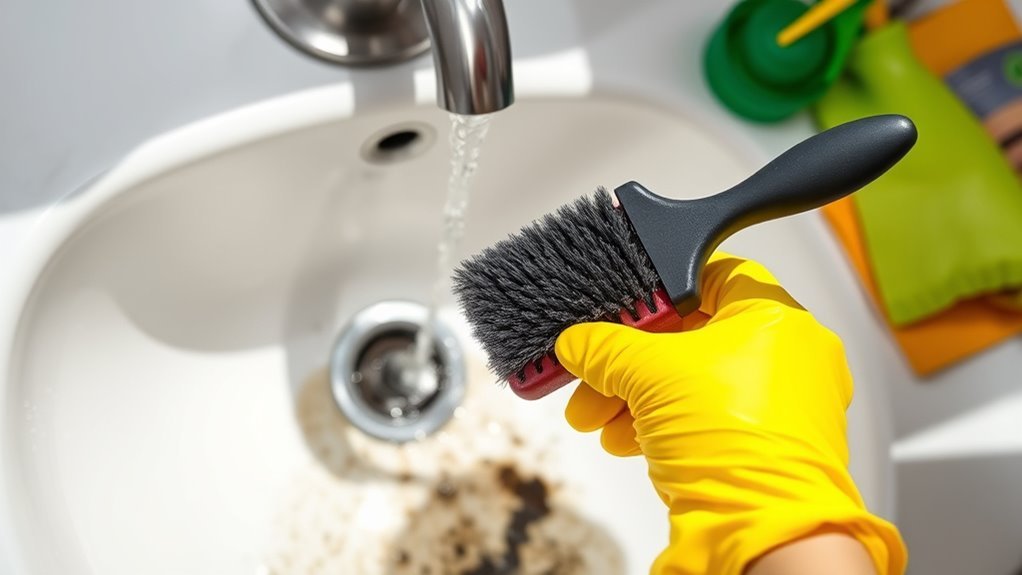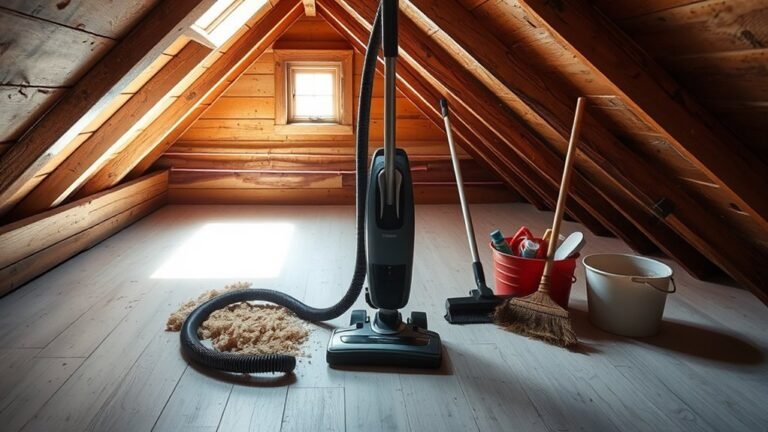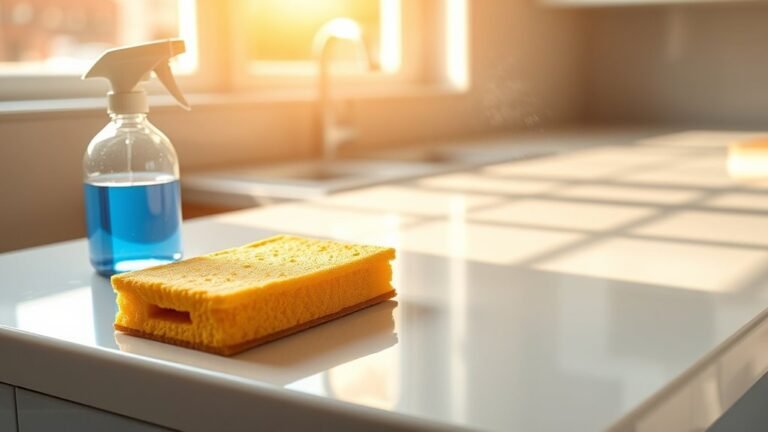Removing Mold From Sink Effectively
To remove mold from your sink effectively, start by wearing gloves and a mask for safety. Use natural cleaners like undiluted white vinegar or a baking soda paste—apply, let sit, scrub gently, then rinse well. Make sure your sink is dry and ventilated to prevent mold from coming back. Fix any leaks and wipe the sink after each use. Keep your sink clean consistently to keep mold away. You can find out more about safe cleaning methods and prevention tips next.
Identifying Mold in Your Sink

Mold often appears as dark spots or patches around your sink, especially in damp, hard-to-reach areas like under the faucet or around the drain. To reclaim your space, you need to recognize the common mold types that thrive on various sink surfaces. Black mold, green mold, and white mold each have distinct appearances and textures. Black mold is typically slimy and dark, while green mold looks fuzzy, and white mold appears powdery. These molds can grow on ceramic, stainless steel, or even plastic sink surfaces. By identifying the mold type and where it clings, you gain the freedom to choose targeted cleaning methods. Spotting mold early lets you act fast, preventing it from spreading and compromising your sink’s cleanliness and your home’s health.
Causes of Mold Growth in Sinks
Because sinks are often damp and poorly ventilated, they create the perfect environment for mold to thrive. Mold spores, which are everywhere, settle in these moist areas and start growing when moisture levels remain high. If you want to keep your sink mold-free, understanding these causes is essential.
| Cause | Explanation |
|---|---|
| High Moisture | Constant water exposure keeps surfaces wet, encouraging mold growth. |
| Poor Ventilation | Limits air circulation, trapping moisture and mold spores. |
| Organic Residue | Food particles and soap scum feed mold spores, accelerating growth. |
Safety Precautions When Handling Mold

Since sinks provide the perfect conditions for mold growth, you need to handle it carefully to protect yourself. Mold spores can pose serious health risks, especially if you’re sensitive or have respiratory issues. Before you start, make sure to wear proper protective gear such as gloves, a mask, and goggles to avoid direct contact and inhalation of spores. Ventilate the area by opening windows or using a fan to keep fresh air flowing. Avoid touching mold with bare hands, and never mix cleaning chemicals, as that can create harmful fumes. Taking these precautions guarantees you stay safe and free while tackling mold in your sink, letting you regain control over your space without risking your well-being.
Natural Cleaning Solutions for Mold Removal
If you’re looking for a safer way to tackle mold in your sink, natural cleaning solutions offer effective alternatives to harsh chemicals. You can embrace eco friendly solutions that are gentle on both your health and the environment without sacrificing mold-fighting power. Vinegar effectiveness is well-known for breaking down mold and preventing its return.
Here are three natural options to evaluate:
- White vinegar: Spray undiluted vinegar on moldy areas, let it sit for an hour, then scrub and rinse.
- Baking soda: Mix with water to form a paste, apply to mold, scrub gently, then rinse.
- Tea tree oil: Add a teaspoon to water in a spray bottle, spritz mold spots, wait, then wipe clean.
These methods provide freedom from toxins while keeping your sink mold-free.
Using Commercial Mold Removers Safely

While natural solutions can be great for mild mold issues, sometimes you need something stronger to fully eliminate stubborn mold in your sink. That’s where commercial products come in—they offer powerful mold effectiveness that natural remedies might lack. When using these products, make sure you’re in a well-ventilated area to protect your lungs and wear gloves to keep your skin safe. Follow the instructions closely; don’t mix chemicals, as that can create dangerous fumes. Keep kids and pets away during treatment to maintain a safe environment. By respecting these precautions, you can harness the full power of commercial mold removers without sacrificing your freedom or safety. This way, you get a mold-free sink while staying in control of your home’s health.
Step-by-Step Mold Removal Process
Before you start cleaning, you’ll want to identify all the moldy spots around your sink. Next, choose the right cleaning agents that are effective but safe for your surfaces. Don’t forget to take proper safety measures to protect yourself during the process.
Identifying Mold Areas
Where should you start when removing mold from your sink? First, you need to pinpoint the exact spots where mold hides. Using effective mold identification techniques, focus on areas that show visual mold signs like discoloration or fuzzy patches. Mold loves damp, dark spots, so pay close attention there.
Check these key areas carefully:
- Underneath the sink basin and around the drain
- Seals and caulking where water often lingers
- Behind or beneath the faucet and fixtures
Choosing Cleaning Agents
Since mold can be stubborn and vary in type, choosing the right cleaning agent is essential to effectively remove it from your sink. You want a solution that balances chemical effectiveness with your values, especially if you prefer eco friendly options. Traditional mold removers often rely on harsh chemicals, which work fast but can be tough on the environment and your health. Luckily, there are powerful eco friendly alternatives like vinegar, baking soda, and hydrogen peroxide that tackle mold without compromising safety or freedom. When selecting your agent, consider how deeply the mold has penetrated and whether you need a quick fix or a gentle cleaner for regular maintenance. This way, you keep your sink mold-free while staying true to a lifestyle that respects both effectiveness and the planet.
Proper Safety Measures
Taking three essential safety steps will help protect you during the mold removal process. Since different mold types can pose various health risks, it’s vital to prioritize your safety before diving in. Here’s what you need to do:
- Wear protective gear like gloves, goggles, and an N95 mask to avoid inhaling spores or touching irritants.
- Guarantee proper ventilation by opening windows or using fans to reduce mold spore concentration indoors.
- Identify the mold type if possible; some molds release toxins that require professional handling.
Cleaning Different Sink Materials
Although mold can grow on any sink surface, the way you clean it depends on the material. Different sink materials require specific cleaning techniques to avoid damage while effectively removing mold. For stainless steel sinks, use a gentle scrub with baking soda and a soft brush to lift mold without scratching. Porcelain sinks handle stronger cleaners like diluted bleach, but be sure to rinse thoroughly. If your sink is made of natural stone, avoid acidic cleaners; instead, opt for a mild detergent and warm water to protect the surface. Plastic sinks respond well to vinegar solutions and non-abrasive sponges. Knowing your sink materials lets you pick the right cleaning techniques, ensuring mold is removed safely while keeping your sink intact and looking great.
Preventing Mold Recurrence in Your Sink
To keep mold from coming back in your sink, you’ll want to focus on controlling moisture and ensuring proper ventilation. Mold thrives in damp, poorly ventilated areas, so tackling these factors gives you the freedom to enjoy a clean, mold-free sink without constant worry. Consider applying mold resistant coatings to create a durable barrier against spores. Also, managing indoor humidity is key—too much moisture invites mold, so keep humidity levels in check.
Here’s how you can prevent mold recurrence:
- Use a dehumidifier or exhaust fan to improve airflow and reduce humidity.
- Apply mold resistant coatings specifically designed for sinks and surrounding areas.
- Fix leaks promptly and wipe down the sink after use to eliminate excess moisture.
Taking these steps helps you maintain a fresh, mold-free sink effortlessly.
Maintaining Sink Hygiene Regularly
You’ll want to stick to a daily cleaning routine to keep your sink free from mold. Regularly wiping down surfaces and drying the area helps prevent mold growth. Staying consistent with these habits makes a big difference in maintaining sink hygiene.
Daily Cleaning Routine
Since mold thrives in damp environments, keeping your sink clean every day is essential to prevent its growth. Establishing a daily cleaning routine helps you stay ahead of mold buildup and keeps your space fresh. With the right daily maintenance and cleaning supplies, you can enjoy a mold-free sink without hassle. Here’s how to make it simple:
- Wipe down your sink with a mild cleaner after each use to remove moisture and residue.
- Rinse the drain and faucet areas thoroughly to eliminate trapped debris.
- Dry the sink surface with a clean cloth to reduce dampness.
Preventing Mold Growth
Although daily cleaning helps, preventing mold growth requires consistent attention to your sink’s hygiene beyond just wiping it down. You’ll want to invest in mold resistant materials like stainless steel or treated composites for long-lasting protection. Controlling humidity is essential—use a dehumidifier or guarantee proper ventilation to keep moisture low. Regularly check under the sink and around fixtures for leaks that can invite mold. Here’s a simple guide to keep your sink mold-free:
| What to Do | Why It Matters |
|---|---|
| Use mold resistant materials | Limits mold-friendly surfaces |
| Control humidity | Stops mold spores from thriving |
| Fix leaks immediately | Prevents hidden moisture buildup |
When to Call a Professional for Mold Issues
How do you know when mold in your sink has gone beyond a simple cleanup? If you notice persistent mold despite regular cleaning, it’s time to contemplate professional help. Mold can hide in places you can’t reach, making it tricky to eliminate completely on your own. You should call for mold inspection services or professional remediation when:
- The mold covers a large area, typically over 10 square feet.
- You experience health issues like allergies or respiratory problems linked to mold exposure.
- Mold returns quickly after cleaning, signaling a deeper issue.
Getting experts involved frees you from ongoing worry and guarantees mold is removed safely and thoroughly, protecting your home and health with confidence.
Frequently Asked Questions
Can Mold in Sinks Cause Allergic Reactions or Respiratory Problems?
Yes, mold in sinks can definitely trigger allergy symptoms and respiratory issues. If you’re sensitive or have asthma, mold spores can irritate your lungs and cause sneezing, coughing, or even wheezing. You don’t want these problems holding you back from enjoying your freedom. So, it’s smart to keep mold under control to protect your health and breathe easier every day. Don’t ignore those signs—it’s your well-being at stake.
How Long Does It Take for Mold to Grow in a Damp Sink?
You might be surprised how quickly mold can take hold in your sink. The mold growth timeline varies, but in damp, warm conditions with poor ventilation—common sink humidity factors—mold can start appearing within 24 to 48 hours. If you don’t act fast, it can spread and become a persistent problem, limiting your freedom to enjoy a clean, healthy space. Stay vigilant, and you’ll keep your sanctuary mold-free.
Are There Specific Types of Mold Commonly Found in Sinks?
You’ll often find black mold and other toxic mold types lurking in sinks, especially where moisture sticks around. These molds thrive in damp, dark spots and can cause health issues if you don’t deal with them. Knowing this, you can take control by checking your sink regularly and keeping it dry. Don’t let mold limit your freedom—stay proactive and protect your space from these common, pesky invaders.
Can Mold Spores Spread to Other Areas From the Sink?
Yes, mold spores can spread from your sink to other areas if you’re not careful. To keep your space fresh and free, focus on mold prevention tips like ensuring good ventilation and drying surfaces regularly. Using effective sink cleaning techniques, such as scrubbing with vinegar or baking soda, helps stop mold growth at the source. Staying proactive gives you the freedom to enjoy a clean, healthy home without mold worries.
Does Mold Removal Affect Plumbing or Sink Fixtures?
Imagine your sink throwing a tantrum every time you try to clean it—ironic, right? But don’t worry, mold removal usually won’t sabotage your plumbing or fixtures if you’re careful. You just need to pick the right cleaning agents and avoid harsh chemicals that can corrode pipes. Stick to mold prevention tips and regular sink maintenance to keep freedom from mold’s grip while preserving your fixtures. It’s about balance, not battle.






